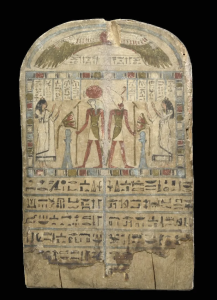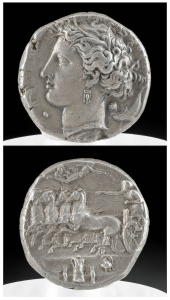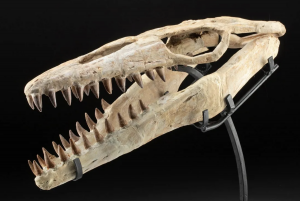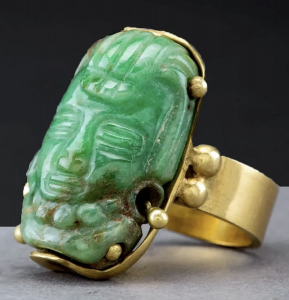Artemis Gallery’s Nov. 16 Exceptional Ancient, Ethnographic & Fine Art Auction offers 250 connoisseur-level selections

Translated Egyptian polychrome wood stele for Hetpamun with hieroglyphic inscription, colorful vignettes. Ex Sabatier collection sold in Paris, 1890. Estimate: $80,000-$120,000

Sicily, Syracuse AR (silver) decadrachm/decadrachm, Time of Dionysios I, circa 405-370 BC. Style of Euainetos, with charioteer. Estimate: $40,000-$60,000

Circa-16th-century CE Indonesian/Dayak peoples wood baby carrier with carved guardians, C-14 radiocarbon dated. Estimate $35,000-$45,000
Many auction entries boast impeccable provenance from prestigious collections and are either book examples, have been museum-exhibited, or both
An unrivaled selection of Ancient Egyptian art is led by a translated polychrome wood stele for Hetpamun with a hieroglyphic inscription and colorful vignettes that include deities, a falcon-headed R-Horakhty and Atum, and women in white worshipping the two gods. From the Late Dynastic Period, 23rd-26th dynasty, circa 712-525 BCE, this fabulous treasure has a long and distinguished line of US and British provenance that goes back to the 1890 sale of the Sabatier collection via Drouot in Paris. It is estimated at $80,000-$120,000.
What a diva! An Egyptian bronze cat with original gold earrings makes its leap from the Late Dynastic Period, Dynasty 26, circa 664-535 BCE. An XRF analysis (the report conveys to the winning bidder) indicates the elegant feline’s leaded-copper composition is consistent with bronzes of the stated time period. Formerly in the collection of Dr W Benson Harer, the piece was exhibited from 2007 through 2023 at California State University’s Fullerton Museum of Art. Estimate: $15,000-$25,000
A multitude of history and culture is seen in a Sicily, Syracuse silver decadrachm/decadrachm from the Time of Dionysios I, circa 405-370 BC. It embodies the style of Euainetos, with the image of a charioteer driving a galloping quadriga, holding a steering kentron in one hand and reins in the other. Nike is shown flying overhead. With provenance from a Tacoma, Washington private collection and, prior to that, Malter Galleries in Encino, California, this important coin is offered with a $40,000-$60,000 estimate.
The extreme skill required to create Roman tesserae mosaics is on full display in a breathtaking circa 2nd century CE panel depicting Tiphys the Thracian – known as the pilot of Jason’s ship the Argo – alongside the personification of helmsmanship. The image is composed of hundreds of individually cut, tiny colored stones, and incorporates Greek inscriptions at the top. Its line of provenance includes both American and French ownership (prior to 1990), and the pre-sale estimate is $50,000-$75,000.
At around the same time the Imperial Roman Empire was at its peak, the ancient Indo-Aryan civilization known as Gandhara was beginning its rapid ascent under the Kushan Empire. Gandhara flourished at the crossroads of India, Central Asia and the Middle East, absorbing cultural influences from diverse civilizations to form its own unique style of art. The influence of classical Hellenistic styles on Gandharan art is undeniable, as seen in Lot 91A, a monumental circa-1st century CE Gandharan dark gray schist head of Buddha. The sculpture’s facial features are both sensuously and realistically carved, with an urna on the forehead. The hair is painstakingly detailed in a traditionally Gandharan ushnisha topknot. Most recently in a West Hollywood private collection, the sculpture is estimated at $20,000-$30,000.
A Chinese Tang Dynasty sancai glazed pottery Bactrian camel, circa 618-907 CE, is decorated in characteristic hues of brown, green and ochre. A saddle or bags appear to be part of the design between the beast’s two humps. This figure is of a type that would have accompanied Tang Dynasty elites in their tombs to ensure reliable transportation would be available in the afterlife. Standing 14.5 inches high, the camel is estimated at $5,000-$7,500.
From the Pre-Columbian category, a stunning gold ring with a Maya jade pendant of the maize god serving as its central stone deserves the description of “unique.” Originating in the Southern Mexico to Guatemala region, it dates to circa 300-500 AD. The carved, string-cut jade stone was set in a contemporary gold ring by designer Janet Hallenberg, who used original drilled suspension holes to incorporate gold balls as earspools. Previously auctioned at Sotheby’s New York (May 9, 2006), the ring is now offered with a $10,000-$15,000 estimate.
A most extraordinary circa-16th-century CE Indonesian/Dayak peoples wood baby carrier is formed in a half-basket shape with a crescent seat and holes and carved loops for attaching the carrier to the mother’s back like a backpack. It is adorned with carved, full-figured guardians to protect the carried baby from evil. Such fully detailed figures were reserved for the highest societal classes. C-14 radiocarbon dating confirmed that the piece is ancient and of the period stated. The relevant report will convey to the winning bidder. Formerly in a Hawaii private collection, it will cross the auction block with a $35,000-$45,000 estimate.
Native American art highlights include a rare circa-1920s Maria Martinez (San Ildefonso Pueblo, 1887-1980) lidded blackware box. It is signed simply “Maria” in cursive to the underside, a style employed by the artist on only her earliest works. Measuring 5.25 inches long by 4.125 inches wide by 5 inches high, the vessel exhibits an intense luster with matte decoration. Although it appears to be etched, the decoration was actually applied via a matte slip over the heavily burnished surface, rendering the unmistakable look of Maria Martinez blackware pottery. It is expected to attract a winning bid of $8,000-$12,000.
The oldest object in the sale is the full skull and jaws of a prehistoric marine reptile known as the Prognathodon mosasaur. From the Maastrichtian era (late Cretaceous), circa 83.6 to 66 million years ago, its anatomy included pterygoid teeth to help secure prey, double-hinged jaws as seen in snakes, and flexible skulls enabling the consumption of oversize pieces. With provenance from a private New Jersey collection, the specimen in Artemis’ auction is estimated at $18,000-$25,000.
Artemis Gallery’s fastest growing category, Fine & Visual Art, brings fresh selections to the marketplace, with most consignments coming from the company’s long-time antiquities clients. A unique opportunity presents itself in the form of an authentic Keith Haring (American, 1958-1990) “Born in the USA” art rug. With original Haring paintings out of reach to all but the most deep-pocketed collectors, the logical next avenue to pursue is his applied art, such as ceramics or textiles. The large vintage Haring rug depicts seven figures dancing jubilantly upon the American Flag, reflecting the artist’s hope for a joyous, harmonious society. Nearly 8ft wide, is has two labels on verso: “Estate of Keith Haring” and “Wool of New Zealand.” Sourced from a Santa Fe, New Mexico private collection, it comes to auction with a $7,000-$9,000 estimate.
Artemis Gallery’s Thursday, Nov. 16, 2023 Exceptional Ancient, Ethnographic & Fine Art Auction will start at 8 a.m. MT / 10 a.m. ET. The company ships worldwide and has its own in-house white-glove packing and shipping department to ensure quality control. Absentee bidding is currently in progress. Detailed, authoritative descriptions and multiple photographic views of each auction lot may be viewed in the online catalog. All ancient items have been legally acquired and are legal to resell, if desired. A Certificate of Authenticity will accompany each lot. For additional information about any item in the auction, call Teresa Dodge at 720-890-7700 or email teresa@artemisgallery.com. Bid absentee or live online through LiveAuctioneers.
Teresa Dodge
Artemis Gallery
+1 720-890-7700
email us here
Visit us on social media:
Facebook
Twitter
LinkedIn
Legal Disclaimer:
EIN Presswire provides this news content "as is" without warranty of any kind. We do not accept any responsibility or liability for the accuracy, content, images, videos, licenses, completeness, legality, or reliability of the information contained in this article. If you have any complaints or copyright issues related to this article, kindly contact the author above.


